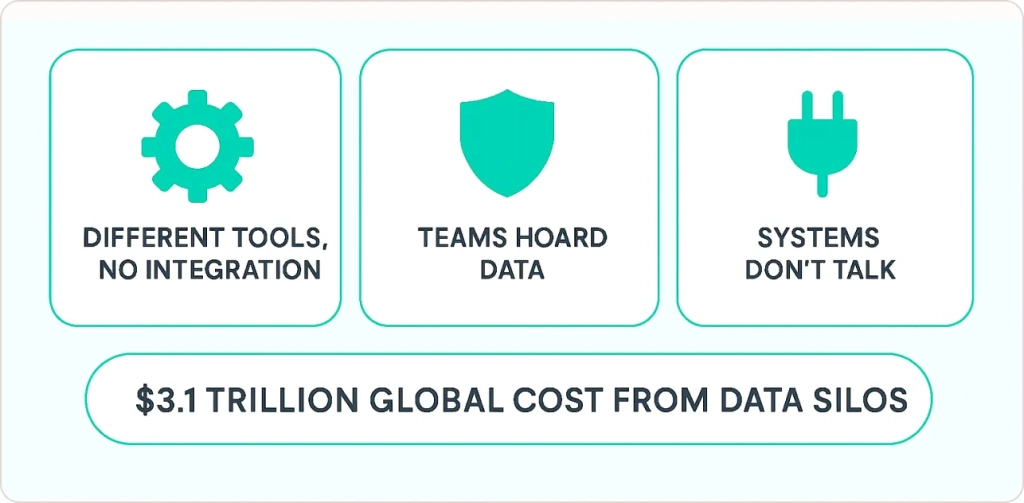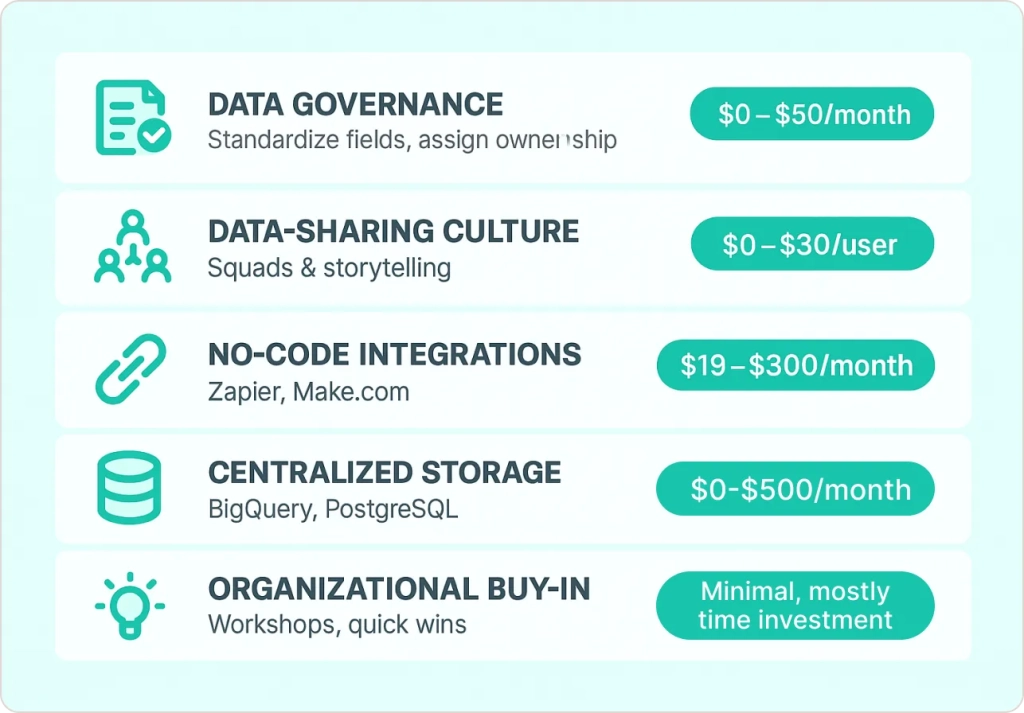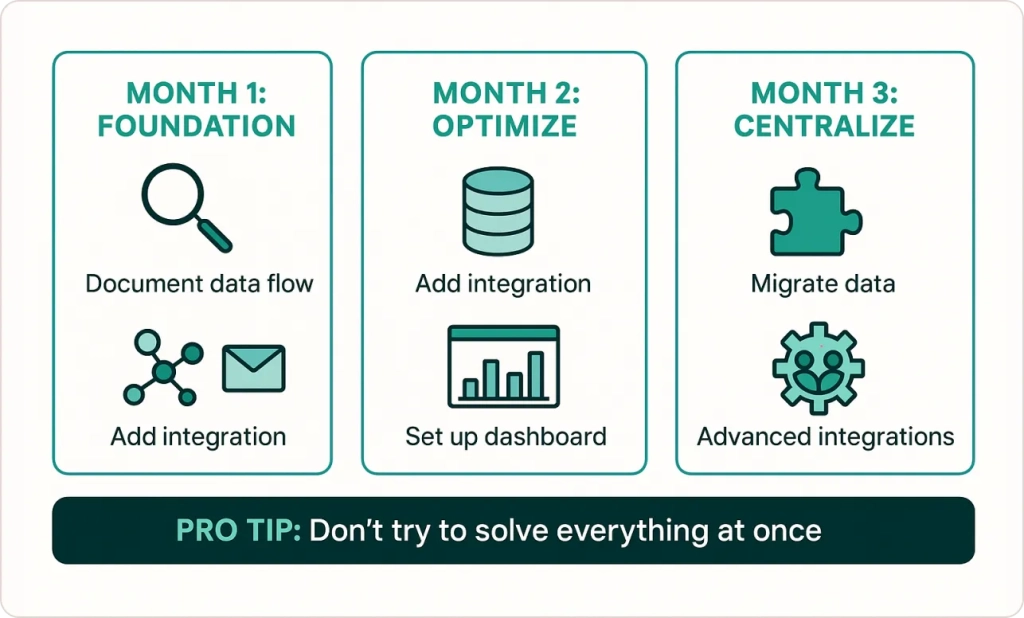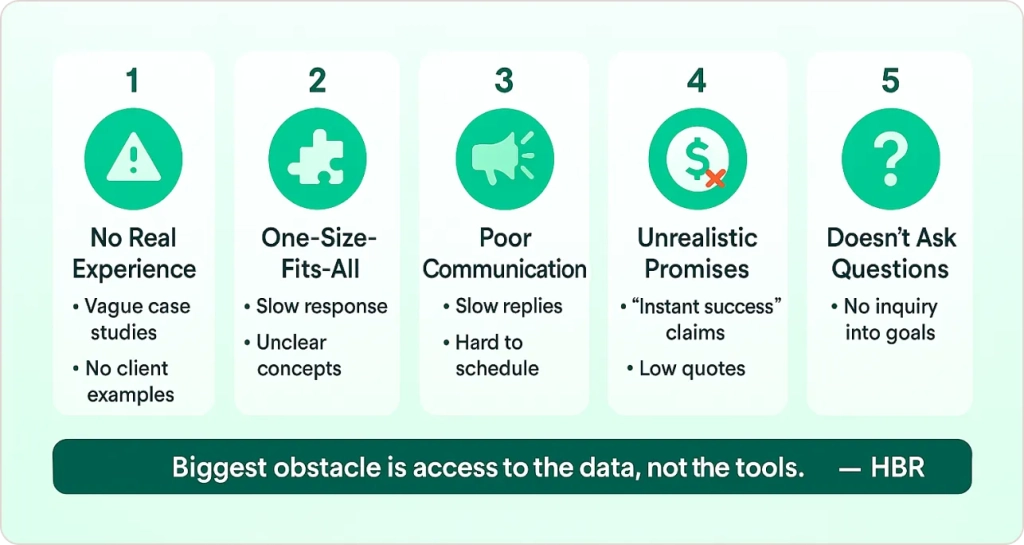Highlights:
- 66% of business data goes unused due to silos, costing SMBs $12.9M+ annually
- Traditional enterprise solutions require massive overhaul investments of $50K+ annually
- 5 proven strategies work for budgets under $500/month
- Real case study: 10-person team unified Shopify, GA4, and Klaviyo for $250/month
- Free templates and ROI calculator included
- Step-by-step implementation roadmap prevents costly mistakes
Introduction
If you’ve ever found yourself manually copying data between your CRM, analytics platform, and marketing tools, you’re definitely not alone.
When I first started helping small businesses with their data challenges, I was shocked to discover that according to Google Cloud research, 66% of business data sits unused in silos. Even more surprising? According to Gartner research, bad data costs organizations an average of $12.9 million annually.
Here’s the thing: 2025 has brought incredible advances in affordable data integration tools, but most advice out there focuses on enterprise-level solutions that require a massive overhaul and cost $50,000+ annually. That’s completely out of reach for the small and mid-size businesses I work with every day.
In this guide, I’ll walk you through exactly how to break down data silos without breaking your budget or forcing a complete tech stack overhaul. You’ll learn practical strategies that work for teams under 50 people, affordable tools that actually deliver ROI, and how to get organizational buy-in without a massive change management project.
What Is a Data Silo (And Why They Persist in Small Businesses)

Let me be honest with you: understanding what a data silo is the first step to solving this expensive problem that’s probably costing your business more than you realize.
From my experience working with hundreds of SMBs, data silos are isolated repositories of information that are generally disconnected from other data sources. They persist for three main reasons that have nothing to do with company size and everything to do with how businesses grow organically.
The Reality of How Silos Form
Operational Silos happen when different departments use different tools. Your sales team loves their CRM, marketing swears by their automation platform, and finance has their own reporting system. Each tool works great individually, but they don’t talk to each other.
Cultural Silos develop when teams protect “their” data. I’ve seen marketing teams hesitant to share campaign performance data with sales, and finance departments that guard budget information like state secrets.
Technical Silos occur when tools can’t integrate easily. Maybe your e-commerce platform doesn’t connect to your email marketing tool, or your analytics data can’t flow into your customer support system.
Here’s what I’ve learned after years of helping companies tackle this: most businesses accumulate tools gradually, choosing the best solution for each immediate need without thinking about how everything connects. It’s not poor planning – it’s just how small businesses operate when they’re focused on growth.
“We had customer data in five different systems, and nobody could tell me our true customer lifetime value. It was frustrating because we knew the information was there, but it was scattered everywhere.”
— Sarah Chen, Operations Manager at a growing e-commerce brand
The Hidden Costs That Add Up Fast
The real problem isn’t the silos themselves – it’s what they cost you every single day.
Time Redundancy: According to Forrester research, knowledge workers spend an average of 12 hours weekly “chasing data.” At a $75,000 annual salary, that’s $1,500+ monthly in lost productivity just for one person.
Decision-Making Delays: When your sales team can’t see marketing campaign performance in real-time, they miss opportunities to capitalize on hot leads. When finance can’t access current customer acquisition costs, they make budget decisions on outdated information.
Infrastructure Waste: Here’s something most people don’t realize – data silos often lead to paying for duplicate functionality. I’ve seen companies paying for reporting features in five different tools when they could get better insights from one unified system.
Research from IDC reveals that data silos cost the global economy a whopping $3.1 trillion annually. For a $2 million revenue company, fragmented data systems typically result in 23% lower revenue growth compared to those with integrated data strategies.
Red flag alert: If your team regularly says “I need to check three different systems to answer that question,” you’re dealing with expensive data silos that need immediate attention.
The 5 Practical, Budget-Friendly Strategies I Use to Break Down Data Silos

After working with dozens of companies on this exact problem, I’ve developed a systematic approach that works without massive budgets or technical overhauls. Here are the five strategies that consistently deliver results:
1. Start with Data Governance (Even If You’re a 5-Person Team)
Why this matters: Data governance sounds enterprise-y, but it’s actually the foundation that makes everything else work.
From my experience, the companies that successfully break data silos start by getting everyone aligned on basic data standards. This doesn’t require expensive software – it requires clear agreements about how data gets created, stored, and shared.
Here’s what I always help teams establish first:
Data Ownership: Assign one person per department to be responsible for data quality and sharing. In small companies, this might be the same person for multiple areas, and that’s fine.
Field Standardization: Agree on consistent formats for key data points. Customer names, product categories, date formats – standardize these across all systems.
Access Roles: Define who can see what data and when. This prevents the “data hoarding” behavior that creates cultural silos.
Tools that work: Notion, Airtable, or even Google Workspace can handle data governance documentation for most small businesses. Budget: $0-$50/month.
Pro tip: Start with your most critical customer data fields. Get those standardized across systems before tackling everything else.
For businesses needing more comprehensive data analytics consulting services, having expert guidance can accelerate this process significantly.
2. Create a Data-Sharing Culture (Without Corporate Bureaucracy)
The cultural piece is often harder than the technical piece, but here’s what I’ve learned works for small teams.
Cross-Functional Data Squads: Form small groups (3-4 people) from different departments who meet monthly to review shared metrics and identify data gaps. Keep it informal but consistent.
Data Storytelling Sessions: Host monthly 30-minute sessions where different teams share what their data is telling them. Marketing shows campaign performance, sales discusses pipeline trends, operations covers efficiency metrics.
Shared Dashboards: Create simple, shared dashboards that everyone can access. Even basic Google Data Studio or Looker Studio dashboards help teams see how their work impacts others.
Tools that work: Slack for communication, Loom for recorded data walkthroughs, Miro for collaborative planning. Budget: $0-$30/user/month.
Here’s my rule: Make data sharing easier than data hoarding. If it takes more effort to keep information siloed than to share it, people will naturally collaborate.
“Once we started our monthly data sharing sessions, marketing finally understood why sales was struggling with certain leads. It completely changed how we qualify prospects.”
— Mike Rodriguez, Sales Director at a SaaS startup
3. Implement Cost-Effective Integration (My Step-by-Step Approach)
This is where most small businesses get overwhelmed, but it doesn’t have to be complicated.
Start with the Low-Hanging Fruit: Identify your two most important systems that don’t currently connect. Usually, this is CRM + email marketing or e-commerce + analytics.
Use No-Code Integration Tools: Zapier pricing starts at just $19.99 for the Starter plan, Make.com (formerly Integromat), or Airbyte can connect most business tools without custom development. I typically recommend starting with Zapier because it’s most beginner-friendly.
Leverage Existing APIs: Many tools have built-in integrations you might not know about. Shopify connects directly to Google Analytics 4, HubSpot integrates with most email platforms, and most CRMs can sync with accounting software.
Implementation Strategy I Use:
- Map your current data flow (usually takes 2-3 hours)
- Identify the top 3 integration points that would save the most time
- Set up one integration at a time and test thoroughly
- Document the process for team training
Tools and budgets:
- Zapier: $0-$300/month depending on automation volume
- Stitch Data or Airbyte: $0-$200/month for small data volumes
- Supermetrics: $99-$399/month for marketing data integration
Red flag alert: Avoid “integration platforms” that require 6-month contracts or charge setup fees above $1,000. Legitimate small business solutions should let you start small and scale up.
Our data engineering services can help you implement these integrations faster and avoid common pitfalls that derail DIY projects.
4. Centralize Data Storage (Without Enterprise Complexity)
Here’s something I tell every client: You don’t need a million-dollar data warehouse to centralize your business data.
For most small businesses, a hybrid approach works best – keep transactional data in operational systems, but create a central hub for reporting and analytics.
My Recommended Approach:
Google BigQuery or Snowflake Free Tier: Both offer generous free tiers that handle most SMB needs. BigQuery gives you 1TB of querying monthly free, which is more than most small businesses use.
PostgreSQL or DuckDB: For companies that want to keep everything on-premises or have specific compliance requirements. Open-source options that scale with your needs.
Hybrid Data Lakes: Use cloud storage (Google Cloud Storage, AWS S3) for raw data archival, connected to BigQuery or Snowflake for analysis.
Implementation Steps:
- Start with your most important datasets (usually customer and revenue data)
- Set up automated daily or weekly syncs from operational systems
- Build basic reporting dashboards
- Gradually add more data sources as the team gets comfortable
Budget expectations: $0-$500/month for most companies under 50 employees, scaling based on data volume and query frequency.
For teams needing guidance on implementing scalable business intelligence solutions, professional consulting can ensure your architecture scales properly from day one.
5. Get Organizational Buy-In (My Change Management Framework)
This is where I see most data projects fail – not because of technical issues, but because teams resist change.
Here’s the framework I use to get everyone excited about data integration instead of fearing it:
Start with Quick Wins: Identify one integration that saves someone 2-3 hours weekly. Implement it first and celebrate the success loudly.
Show, Don’t Tell: Instead of talking about benefits, demonstrate them. Show the sales team how unified data helped them close a deal faster. Show marketing how integrated analytics revealed their most profitable campaigns.
Address Fears Directly: Most resistance comes from fear – fear of job changes, fear of making mistakes, fear of technology. Address these concerns explicitly in team meetings.
Create Data Champions: Identify enthusiastic early adopters in each department. Give them extra training and let them help onboard their colleagues.
My Workshop Format:
- 90-minute kickoff session explaining the why and what
- Department-specific 30-minute training sessions
- Monthly check-ins for the first quarter
- Celebration of wins and lessons learned
Tools for change management: Typeform for feedback collection, MURAL for collaborative planning, Notion for documentation and training materials.
If you’re looking for expert help with marketing analytics integration specifically, our consultants understand both the technical and cultural challenges.
Real Case Study: How a 10-Person E-commerce Brand Connected Everything for $250/Month
Let me share a recent success story that perfectly illustrates these principles in action.
The Client: A growing e-commerce brand selling sustainable home goods, 10 employees, $2M annual revenue.
The Problem: Their data was scattered across Shopify (sales), Google Analytics 4 (website behavior), Klaviyo (email marketing), and QuickBooks (finances). The marketing manager spent 15 hours weekly creating reports by manually pulling data from each system.
“I was drowning in spreadsheets. Every Monday, I’d spend half the day just collecting data from different systems to create our weekly performance report. By the time I finished, the data was already outdated.”
— Jessica Martinez, Marketing Manager
The Solution I Designed:
Phase 1 (Month 1): Connected Shopify to GA4 using built-in integration (free), unified customer data in Klaviyo using Shopify’s native sync ($0 additional cost).
Phase 2 (Month 2): Set up Zapier automations to sync new customers and orders across all systems ($49/month Zapier plan).
Phase 3 (Month 3): Created a Google Data Studio dashboard pulling from all connected sources, set up BigQuery to store historical data for advanced analysis ($150/month average usage).
Total Monthly Cost: $250 (Zapier + BigQuery + tool subscriptions they already had)
Results After 6 Months:
- Reporting time reduced from 15 hours to 2 hours weekly
- Customer lifetime value insights led to 18% increase in email campaign performance
- Inventory forecasting accuracy improved by 35%
- ROI on integration investment: 400%+ in the first year
Here’s what made this successful: We started small, focused on immediate pain points, and built team confidence before tackling more complex integrations.
This approach demonstrates how to break data silos effectively without requiring a massive overhaul of existing systems or expensive enterprise solutions.
Your Step-by-Step Implementation Roadmap

Based on years of helping companies through this process, here’s exactly how I recommend approaching data silo elimination:
Month 1: Foundation and Quick Wins
Week 1-2: Document current data flow and identify top 3 integration opportunities
Week 3: Implement your easiest, highest-impact integration (usually CRM + email marketing)
Week 4: Train team on new integration and document the process
Month 2: Expand and Optimize
Week 1-2: Add second integration based on lessons learned from first
Week 3-4: Set up basic shared reporting dashboard using integrated data
Month 3: Centralize and Scale
Week 1-2: Evaluate data centralization options based on current volume and needs
Week 3-4: Implement chosen solution and migrate priority datasets
Months 4-6: Advanced Integration and Culture
- Add remaining integrations based on ROI analysis
- Develop team competency in data analysis
- Create standardized processes for future tool evaluation
Pro tip: Don’t try to solve everything at once. I’ve seen companies get overwhelmed trying to integrate 10 systems simultaneously. Focus on 1-2 integrations per month and do them well.
For companies needing accelerated implementation timelines, our Google Analytics consulting services can help you set up proper tracking and integration foundations quickly.
Red Flags to Avoid During Implementation

After seeing dozens of integration projects, here are the warning signs that usually predict problems:
1. They Can’t Show You Real Experience
Warning signs: Vague descriptions of “many successful implementations,” inability to provide specific client examples, no verifiable references from similar projects.
Professional partners readily share success stories and client testimonials. If they’re evasive about their experience, there’s probably a good reason.
2. One-Size-Fits-All Approach
Warning signs: Cookie-cutter solutions rarely work for unique business needs. Be wary if partners immediately push specific tools without understanding your requirements.
Strong partners ask detailed questions about your business, data, and objectives before proposing anything.
3. Poor Communication From the Start
Warning signs: Slow responses to emails and calls, inability to explain concepts clearly, difficulty scheduling meetings or calls.
Good communication sets the foundation for successful partnerships. If they’re hard to reach now, imagine how frustrating the project will be.
4. Unrealistic Promises or Suspiciously Low Prices
Warning signs: Promises of “instant BI success,” quotes significantly lower than market rates, no discussion of potential challenges.
Harvard Business Review research shows that the biggest obstacle to using advanced data analysis isn’t skill base or technology; it’s plain old access to the data. Experienced partners understand this complexity.
5. They Don’t Ask Questions
Warning signs: No questions about business objectives, little interest in understanding your challenges, assumptions about your requirements.
Partners should want to understand your business context, technical environment, and success criteria. This information is essential for proposing appropriate solutions and accurate timelines.
What I Tell Every Client About Long-Term Success
Breaking down data silos isn’t a one-time project – it’s an ongoing capability you build in your organization.
Here’s what I’ve learned after helping dozens of companies through this process: the organizations that succeed long-term are the ones who treat data integration as a core business competency, not just a technical project.
The companies that get the best results focus on three things: starting with clear business objectives rather than cool technology, building internal expertise gradually rather than depending entirely on vendors, and measuring success by business outcomes rather than technical metrics.
How long does it typically take to see ROI from data integration investments?
Most companies see immediate time savings within 2-4 weeks of implementing their first integration. Meaningful business insights typically emerge within 2-3 months once you have enough connected data to identify patterns and opportunities.
With the right approach, you can break data silos without massive budgets or complex enterprise solutions. Focus on solving real problems for real people, start small and build confidence, and remember that perfect integration isn’t the goal – better business decisions are.
The roadmap I’ve outlined here – from governance to culture to affordable tools – requires effort and patience, but it’s completely achievable for any organization willing to approach it systematically.
“The key insight was realizing we didn’t need to replace our entire tech stack. We just needed to connect what we already had. Six months later, we’re making decisions with complete data for the first time in years.”
— David Park, CEO of a 25-person marketing agency
The Bottom Line: You don’t need a massive overhaul to solve your data silo problems. With the right strategy, affordable tools, and systematic implementation, you can transform how your team accesses and uses data while staying within a reasonable budget.
If you’re ready to transform how your team accesses and uses data, our comprehensive data analytics consulting services can help you implement these strategies faster and avoid the common pitfalls that derail DIY projects.














